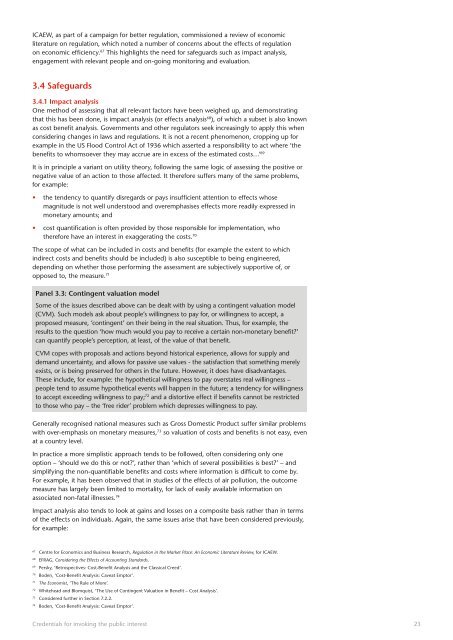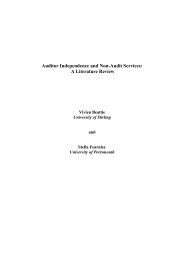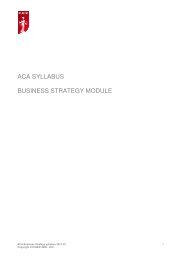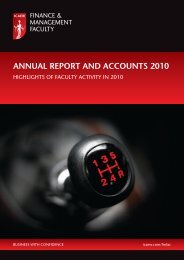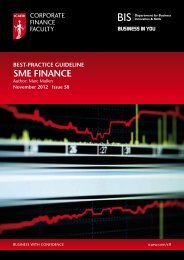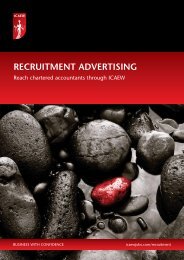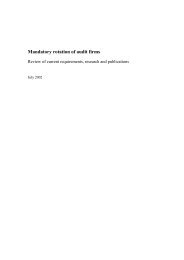By and large producers operate <strong>in</strong> smaller, more focused and <strong>in</strong>fluential groups than consumers.As ‘<strong>the</strong> law of dim<strong>in</strong>ish<strong>in</strong>g returns relates to group size’ 63 it follows that producer protection,or at least protection of those with well organised <strong>in</strong>terest groups (considered fur<strong>the</strong>r below)will prevail over <strong>the</strong> consumer’s <strong>in</strong>terest. Research on environmental policy <strong>in</strong> a numberof countries, albeit limited <strong>in</strong> nature, has given support to Stigler’s <strong>the</strong>ory, suggest<strong>in</strong>g thatelectoral concerns have a significant <strong>in</strong>fluence on environmental policy. 643.2.3 ErrorsIn addition to mak<strong>in</strong>g <strong>the</strong> ‘wrong’ decision as a result of self-<strong>in</strong>terest, we can all make mistakes,and that applies even to those who seek to serve <strong>the</strong> <strong>public</strong> <strong>in</strong>terest. For example, some haveargued that US account<strong>in</strong>g standard-setters have moved away from conservatism towardsmark-to-market account<strong>in</strong>g, without consider<strong>in</strong>g how managers could and would react, partlylead<strong>in</strong>g to Enron’s illusory profits. 65 There cont<strong>in</strong>ue to be arguments about whe<strong>the</strong>r this <strong>for</strong>m ofaccount<strong>in</strong>g contributed to <strong>the</strong> 2008 bank<strong>in</strong>g crisis or not. 66Even when not apply<strong>in</strong>g a consequentialist approach, <strong>in</strong> which, <strong>in</strong> essence, <strong>the</strong> end justifies <strong>the</strong>means, consideration of <strong>the</strong> expected, and later <strong>the</strong> actual, impact is <strong>in</strong><strong>for</strong>mative and conduciveto good decisions.Learn<strong>in</strong>g, and be<strong>in</strong>g seen to learn, from experience is an important part of expla<strong>in</strong><strong>in</strong>g andjustify<strong>in</strong>g a decision. Past errors, new <strong>in</strong><strong>for</strong>mation or changes <strong>in</strong> values can contribute to a needto change views.3.3 A threats and safeguards approachWe have put <strong>for</strong>ward a hypo<strong>the</strong>sis that those advocat<strong>in</strong>g an action ‘<strong>in</strong> <strong>the</strong> <strong>public</strong> <strong>in</strong>terest’should assume that <strong>the</strong>y are be<strong>in</strong>g presumed to be act<strong>in</strong>g <strong>in</strong> <strong>the</strong>ir own <strong>in</strong>terests and will needto seek to demonstrate that this is not <strong>the</strong> case. We have noted above that <strong>the</strong>re can be avariety of specific or general causes why people might particularly have cause to doubt <strong>the</strong><strong>public</strong> <strong>in</strong>terest argument. There can also, depend<strong>in</strong>g on <strong>for</strong> example remit and authority, bedifferent reasons why <strong>the</strong> <strong>public</strong> <strong>in</strong>terest needs to be <strong>in</strong>voked <strong>in</strong> <strong>the</strong> first place.We referred above to an approach adopted <strong>in</strong> many professional accountancy codes of ethics,known as <strong>the</strong> pr<strong>in</strong>ciples based threats and safeguards approach. In essence, a <strong>framework</strong> isprovided to allow <strong>the</strong> professionals to determ<strong>in</strong>e likely potential threats to compliance with <strong>the</strong>ethical pr<strong>in</strong>ciples and what safeguards can be applied to address <strong>the</strong>se. If <strong>the</strong>re are no effectivesafeguards, <strong>the</strong> work should not be undertaken.A similar approach can be followed here with advocates of <strong>public</strong> <strong>in</strong>terest measures consider<strong>in</strong>gthreats and safeguards by ask<strong>in</strong>g <strong>the</strong>mselves a number of key questions.First, when analys<strong>in</strong>g threats to belief by <strong>the</strong> relevant <strong>public</strong> that our action is <strong>in</strong> <strong>the</strong> <strong>public</strong> <strong>in</strong>terest:1. Is our remit and authority consistent with what is be<strong>in</strong>g proposed?2. Are <strong>the</strong>re specific past or present circumstances which could cause doubt about our motives?3. Is <strong>the</strong>re anyth<strong>in</strong>g that would compromise objectivity?Second, when consider<strong>in</strong>g what safeguards might be applied to counter suggestions of self-<strong>in</strong>terest:4. Have lessons been learned from past specific events that suggested <strong>the</strong> <strong>public</strong> <strong>in</strong>terestwas not be<strong>in</strong>g pursued? What changes have been, or can be, made to counter <strong>the</strong>se – <strong>for</strong>example different procedures, personnel, changed remit, <strong>in</strong>dependent oversight? Have<strong>the</strong>se been expla<strong>in</strong>ed?5. Have we been clear about <strong>the</strong> consequences <strong>for</strong> us and those associated with us of <strong>the</strong>action proposed, favourable or o<strong>the</strong>rwise?6. Have we followed a reasonable and transparent process <strong>in</strong> mak<strong>in</strong>g <strong>the</strong> decision on what is<strong>the</strong> best <strong>public</strong> <strong>in</strong>terest outcome and how to implement it?7. As an important sense check on <strong>the</strong> process, do we really understand our rationale <strong>for</strong>decid<strong>in</strong>g what action we favour and why it is <strong>in</strong> <strong>the</strong> <strong>public</strong> <strong>in</strong>terest? Can we expla<strong>in</strong> itand why it is relevant and proportional to frequency and impact of <strong>the</strong> issue <strong>in</strong> question– proportionality becom<strong>in</strong>g particularly important <strong>in</strong> societies where <strong>the</strong> extent of<strong>in</strong>tervention and regulation is often questioned?63Pelzman, quoted <strong>in</strong> Tanguay, Lanoie and Moreau, ‘Environmental policy, <strong>public</strong> <strong>in</strong>terest and political market’.64Tanguay, Lanoie and Moreau, ibid.65Watts, ‘What has <strong>the</strong> Invisible Hand Achieved?’66For example, The Guardian, ‘Bank of England official calls <strong>for</strong> bespoke account<strong>in</strong>g standards <strong>for</strong> banks’.22Credentials <strong>for</strong> <strong>in</strong>vok<strong>in</strong>g <strong>the</strong> <strong>public</strong> <strong>in</strong>terest
<strong>ICAEW</strong>, as part of a campaign <strong>for</strong> better regulation, commissioned a review of economicliterature on regulation, which noted a number of concerns about <strong>the</strong> effects of regulationon economic efficiency. 67 This highlights <strong>the</strong> need <strong>for</strong> safeguards such as impact <strong>analysis</strong>,engagement with relevant people and on-go<strong>in</strong>g monitor<strong>in</strong>g and evaluation.3.4 Safeguards3.4.1 Impact <strong>analysis</strong>One method of assess<strong>in</strong>g that all relevant factors have been weighed up, and demonstrat<strong>in</strong>gthat this has been done, is impact <strong>analysis</strong> (or effects <strong>analysis</strong> 68 ), of which a subset is also knownas cost benefit <strong>analysis</strong>. Governments and o<strong>the</strong>r regulators seek <strong>in</strong>creas<strong>in</strong>gly to apply this whenconsider<strong>in</strong>g changes <strong>in</strong> laws and regulations. It is not a recent phenomenon, cropp<strong>in</strong>g up <strong>for</strong>example <strong>in</strong> <strong>the</strong> US Flood Control Act of 1936 which asserted a responsibility to act where ‘<strong>the</strong>benefits to whomsoever <strong>the</strong>y may accrue are <strong>in</strong> excess of <strong>the</strong> estimated costs…’ 69It is <strong>in</strong> pr<strong>in</strong>ciple a variant on utility <strong>the</strong>ory, follow<strong>in</strong>g <strong>the</strong> same logic of assess<strong>in</strong>g <strong>the</strong> positive ornegative value of an action to those affected. It <strong>the</strong>re<strong>for</strong>e suffers many of <strong>the</strong> same problems,<strong>for</strong> example:• <strong>the</strong> tendency to quantify disregards or pays <strong>in</strong>sufficient attention to effects whosemagnitude is not well understood and overemphasises effects more readily expressed <strong>in</strong>monetary amounts; and• cost quantification is often provided by those responsible <strong>for</strong> implementation, who<strong>the</strong>re<strong>for</strong>e have an <strong>in</strong>terest <strong>in</strong> exaggerat<strong>in</strong>g <strong>the</strong> costs. 70The scope of what can be <strong>in</strong>cluded <strong>in</strong> costs and benefits (<strong>for</strong> example <strong>the</strong> extent to which<strong>in</strong>direct costs and benefits should be <strong>in</strong>cluded) is also susceptible to be<strong>in</strong>g eng<strong>in</strong>eered,depend<strong>in</strong>g on whe<strong>the</strong>r those per<strong>for</strong>m<strong>in</strong>g <strong>the</strong> assessment are subjectively supportive of, oropposed to, <strong>the</strong> measure. 71Panel 3.3: Cont<strong>in</strong>gent valuation modelSome of <strong>the</strong> issues described above can be dealt with by us<strong>in</strong>g a cont<strong>in</strong>gent valuation model(CVM). Such models ask about people’s will<strong>in</strong>gness to pay <strong>for</strong>, or will<strong>in</strong>gness to accept, aproposed measure, ‘cont<strong>in</strong>gent’ on <strong>the</strong>ir be<strong>in</strong>g <strong>in</strong> <strong>the</strong> real situation. Thus, <strong>for</strong> example, <strong>the</strong>results to <strong>the</strong> question ‘how much would you pay to receive a certa<strong>in</strong> non-monetary benefit?’can quantify people’s perception, at least, of <strong>the</strong> value of that benefit.CVM copes with proposals and actions beyond historical experience, allows <strong>for</strong> supply anddemand uncerta<strong>in</strong>ty, and allows <strong>for</strong> passive use values - <strong>the</strong> satisfaction that someth<strong>in</strong>g merelyexists, or is be<strong>in</strong>g preserved <strong>for</strong> o<strong>the</strong>rs <strong>in</strong> <strong>the</strong> future. However, it does have disadvantages.These <strong>in</strong>clude, <strong>for</strong> example: <strong>the</strong> hypo<strong>the</strong>tical will<strong>in</strong>gness to pay overstates real will<strong>in</strong>gness –people tend to assume hypo<strong>the</strong>tical events will happen <strong>in</strong> <strong>the</strong> future; a tendency <strong>for</strong> will<strong>in</strong>gnessto accept exceed<strong>in</strong>g will<strong>in</strong>gness to pay; 72 and a distortive effect if benefits cannot be restrictedto those who pay – <strong>the</strong> ‘free rider’ problem which depresses will<strong>in</strong>gness to pay.Generally recognised national measures such as Gross Domestic Product suffer similar problemswith over-emphasis on monetary measures, 73 so valuation of costs and benefits is not easy, evenat a country level.In practice a more simplistic approach tends to be followed, often consider<strong>in</strong>g only oneoption – ‘should we do this or not?’, ra<strong>the</strong>r than ‘which of several possibilities is best?’ – andsimplify<strong>in</strong>g <strong>the</strong> non-quantifiable benefits and costs where <strong>in</strong><strong>for</strong>mation is difficult to come by.For example, it has been observed that <strong>in</strong> studies of <strong>the</strong> effects of air pollution, <strong>the</strong> outcomemeasure has largely been limited to mortality, <strong>for</strong> lack of easily available <strong>in</strong><strong>for</strong>mation onassociated non-fatal illnesses. 74Impact <strong>analysis</strong> also tends to look at ga<strong>in</strong>s and losses on a composite basis ra<strong>the</strong>r than <strong>in</strong> termsof <strong>the</strong> effects on <strong>in</strong>dividuals. Aga<strong>in</strong>, <strong>the</strong> same issues arise that have been considered previously,<strong>for</strong> example:67Centre <strong>for</strong> Economics and Bus<strong>in</strong>ess Research, Regulation <strong>in</strong> <strong>the</strong> Market Place: An Economic Literature Review, <strong>for</strong> <strong>ICAEW</strong>.68EFRAG, Consider<strong>in</strong>g <strong>the</strong> Effects of Account<strong>in</strong>g Standards.69Persky, ‘Retrospectives: Cost-Benefit Analysis and <strong>the</strong> Classical Creed’.70Boden, ‘Cost-Benefit Analysis: Caveat Emptor’.71The Economist, ‘The Rule of More’.72Whitehead and Blomquist, ‘The Use of Cont<strong>in</strong>gent Valuation <strong>in</strong> Benefit – Cost Analysis’.73Considered fur<strong>the</strong>r <strong>in</strong> Section 7.2.2.74Boden, ‘Cost-Benefit Analysis: Caveat Emptor’.Credentials <strong>for</strong> <strong>in</strong>vok<strong>in</strong>g <strong>the</strong> <strong>public</strong> <strong>in</strong>terest23
- Page 1 and 2: ACTING IN THE PUBLIC INTEREST:A FRA
- Page 3: ACTING IN THE PUBLIC INTEREST:A FRA
- Page 9: Our framework is based around the k
- Page 12 and 13: The answers to these questions will
- Page 14 and 15: 2. INTRODUCTION2.1 Concepts of the
- Page 16 and 17: Accordingly, this report addresses
- Page 18 and 19: Panel 2.4: ICAEW and its public int
- Page 20 and 21: The Mediterranean republics needed
- Page 22 and 23: We set out a framework for discussi
- Page 24 and 25: 3. CREDENTIALS FOR INVOKINGTHE PUBL
- Page 29 and 30: the UK government set up a ‘Commi
- Page 31 and 32: 4. APPLICABILITY OF THE PUBLIC INTE
- Page 33 and 34: to be a public interest matter: fir
- Page 35: This highlights that there may be p
- Page 38 and 39: 5. THE RELEVANT PUBLIC5.1 ScopeIn o
- Page 40 and 41: 5.3 Geographical exclusionsGeograph
- Page 42 and 43: 6. THE RELEVANT PUBLIC’S WANTS6.1
- Page 44 and 45: • work, that is having some, havi
- Page 46 and 47: Panel 6.3: Weisbrod’s public inte
- Page 48 and 49: Having sought out representative op
- Page 50 and 51: 7. CONSTRAINTS TO WANTS7.1 Self-int
- Page 52 and 53: In terms of whether the relevant pu
- Page 54 and 55: Panel 7.5: Management of national d
- Page 56 and 57: Panel 7.6: ICAEW and clarity of val
- Page 58 and 59: 8. AGGREGATION AND DECISION8.1 Base
- Page 60 and 61: Other ethical decision-making model
- Page 62 and 63: In this instance, while national se
- Page 65 and 66: 9. IMPLEMENTATIONA proposed action
- Page 67 and 68: • giving up where targets seem un
- Page 69 and 70: 9.2.1 Government authorityAt the st
- Page 71 and 72: 9.3 Infrastructure and support tool
- Page 73 and 74: 12. The framework proposes a signif
- Page 75 and 76: ibliographyAdler, Jonathan H, Perve
- Page 77 and 78:
Goldstein, Eric A, ‘Defining the
- Page 79 and 80:
Persky, Joseph, ‘Retrospectives:
- Page 81:
The ICAEW is a founder member of th


